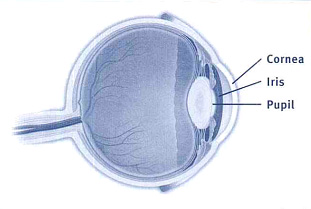Corneal ulcers, or keratitis, can form due to trauma to the cornea, eyelid disease, severe dry eye, fungus, herpes simplex viral infections, and other causes.

Normal Eye Anatomy
There are two very common types of corneal ulcers. Bacterial ulcers tend to be the most painful type of corneal ulcer, and in some cases, if left untreated, can cause severe damage or even corneal perforation. Sterile ulcers, on the other hand, usually cause little or no pain.
Improper care and handling of contact lenses, which can lead to infection, are often causes of corneal ulcers.
The symptoms of corneal ulcers may include:
- pain
- redness
- blurred vision
- tearing
- discharge
- sensitivity to light
Treatment for corneal ulcers depends on the cause. It usually includes steroid eyedrops, anti-inflammatory drops, or antibiotics. In some cases, hospitalization may be necessary in order to administer eyedrops every hour around the clock, intravenous antibiotics, and other treatments. In rare cases when the cornea is severely damaged, a corneal transplant may be necessary to improve vision.








